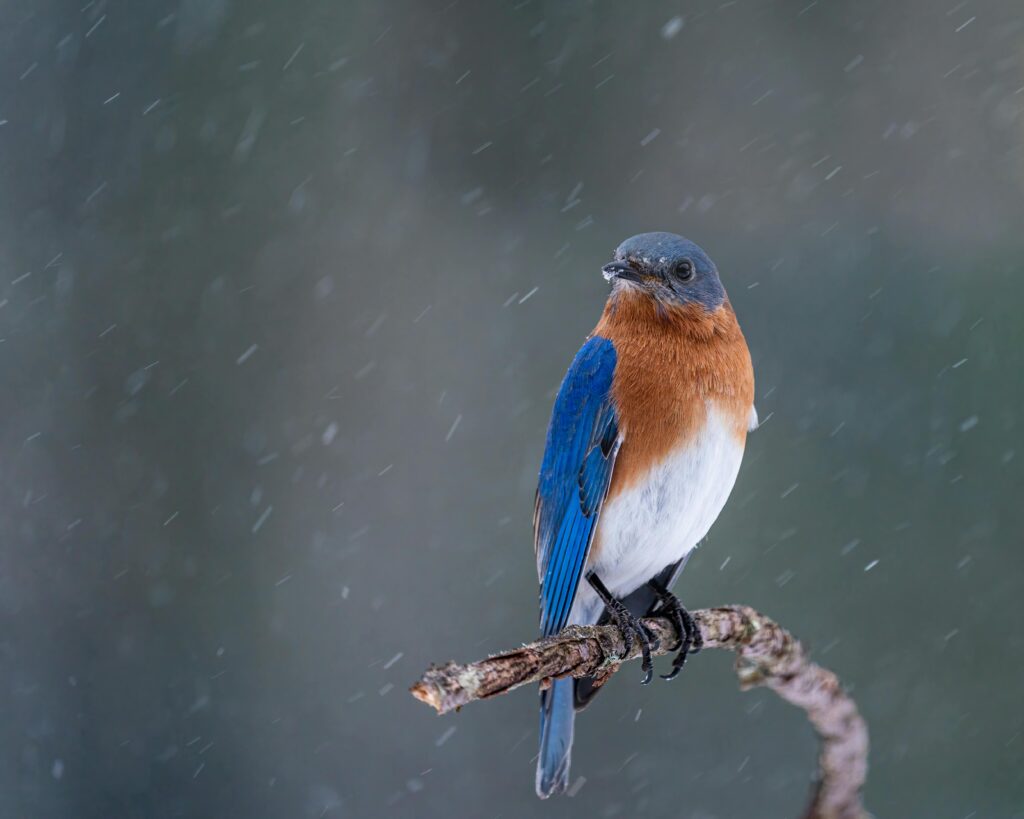 In the spring there are sometimes extended periods of cold, wet weather. This can be a serious problem for survival of bluebird nestlings. Smaller hatchings can not regulate their temperature. Larger nestlings may also be at risk because the mother can’t cover them completely to keep them warm. Also the mother is out getting food (harder to find in cold wet weather) and getting wet and probably bringing dampness into the box during feeding.
In the spring there are sometimes extended periods of cold, wet weather. This can be a serious problem for survival of bluebird nestlings. Smaller hatchings can not regulate their temperature. Larger nestlings may also be at risk because the mother can’t cover them completely to keep them warm. Also the mother is out getting food (harder to find in cold wet weather) and getting wet and probably bringing dampness into the box during feeding.
This situation can also be fatal for young tree swallows as their parents are aerial feeders. Some people feel we should let nature take its course, and allow for survival of the fittest. However, for those with only a few bluebirds in their area, each nestling is precious. There are a few things you can TRY to help out nestlings in this situation.
- *Prevent water from entering the box:
- Make sure the box is facing away from prevailing winds so water doesn’t blow inside.
- Put a drip edge (groove underneath roof or piece of wood to direct water away from entrance hole) and a large overhanging roof on your boxes.
- Make sure cracks are sealed so water is not getting inside box.
- Do not use an open-topped/Bauldry nestbox.
- When nesting season is over, smear DAP clear silicone caulk on the roof and even on the box exterior to waterproof it. (It should dry for at least a week before use.) See more tips.
- Monitor quickly: don’t let babies get chilled or wet. Avoid monitoring during nasty weather, but if you’re concerned about babies, it is better to quickly check them then to find corpses later. If there are concerns, some experienced monitors will check boxes even after day 12, being very careful to prevent premature fledging.
- Do a nest change:
- If nest is soaked, change out the nest (see instructions). It’s a good idea to keep some dry grass or pine needles (or a bag of Timothy hay) on hand for this purpose.
- If bluebirds are feeding earthworms out of desperation, the nest may get gunked up with “fecal glue.” They also may not have time to clean out all the fecal sacs. Again, a nest change is in order.
- Offer mealworms: I think this can make the difference between life and death. I have not lost any broods when feeding mealworms – it’s nothing I’ve tested scientifically but I figure it’s worth it (I have so few bluebirds nesting that every one counts!) During wet cold weather, the female must brood more to keep the nestlings warm, and thus has less time to hunt. More information on how to feed and where to buy.
- Insulate box:
- Consider using Mortite (removable rope caulk), or velcro-ed vent covers to temporarily close up ventilation holes.
- Cut up 1/2″ foil backed insulation and duct tape it to the outside of the nestbox? Remove after cold weather is over? Or try making double walled nestboxes with a layer of foil backed insulation between the interior and exterior walls?
- *Clean out box if nesting fails: If the babies do pass away, clean the box out immediately to encourage another brood. Bury the babies, and put the nest in the trash to avoid attracting predators. You may want to use a dilute (10%) solution of Chlorox spray in the box, let it air out until it is dry, and close it up to get it ready for another try.
If babies are lost, don’t beat yourself up. It’s part of the harsh reality of nature. Many pairs will go on to successfully nest again.
Related information:
- How to do a nest change
- Fecal Glue
- Feeding mealworms
- Dead Tree Swallows found in a nestbox
- Monitoring Tips
- Nestbox pros and cons
- Bluebirding Myths
- Predator and Problem ID (guide to figure out what happened)
- The Downside of Bluebirding
Mother Nature is a big meanie today.
– Joy in Cedar Springs
